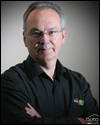Healeys, affordable sports cars
Back then, independent engineers and small shops often teammed up with larger manufacturers in order to build gorgeous sports cars. Donald Healey, for instance, partnered with Austin in 1952 to create the now famous Austin Healeys. First came the 100 and 100M series; their 2.6-liter, 4-cylinder was replaced by a 6-cylinder mill in 1956. The 3000 series became arguably the most civilized, sporting the same classic lines as the 100. The last big Healey of this era (over 42,000 units) was the 3000 MKIII, as shown at the MIAS. Its 2.9L engine generated 150 horsepower through a 4-speed transmission. With only 76.2 mm (3 inches) of ground clearance, this one proved costly in terms of exhaust systems. But Lord knows how much it made people drool...
Triumph, the other popular brand
Triumph enjoyed success and fame during the '50s and '60s in large part because of its renowned TR3 and TR4 models. As proud rivals of the Austin Healeys, Triumphs were initially designed in England. However, it was Italian stylist Michelotti who penned the successful TR4 (on which the TR5 and TR6 were based). The controversial TR7 was the last Triumph to come to America.
In Montreal, the 1973 TR6 on display is a masterpiece from German designer Karmann, who did an outstanding job of updating the silhouette of the old TR4. A 152-hp, 2.5L, 6-cylinder engine and a synchronized, 4-speed transmission were in the mix.
The most beautiful of them all
Without question, the Jaguar XKE (coupe or convertible) is still regarded as one of the most beautiful cars in the world. Designed by Sir William Lyons, the XK family has always offered fairly affordable sports cars. It cost about half the price of a Ferrari and the interior was extremely refined. Coachbuilt by English designers under the supervision of Sir Lyons, the XKE machines were purely about style and performance. The convertible exhibited at this year's MIAS is a 1968 4.2L model.
Plenty of small firms
The United Kingdom is known the world over for its high-quality coachbuilders. One of them is TVR (Trevor Willkinson), which offers beast-like coupes that appear ready to pounce on the road. Established in 1947, this small company has had many different owners through the years, yet its philosophy remained unaltered. The 1990 TVR S2, a replica of the TVR M, is powered by a Ford-sourced 2.9L V6 mated to a 5-speed transmission.
H.F.S. Morgan is another English craftsman who started his own company in the early '30s by creating three-wheel vehicles. In 1936, Morgan introduced its first four-wheel sports car. The styling of Morgans hasn't changed over time. The 1968 Morgan 4/4, for example, stayed true to the company's roots. Interestingly, it offered seating for two additional passengers. Ford supplied a number of 4-cylinder engines, including the race-prepared 1,600-cc Cortina.
photo:Philippe Champoux
Back then, independent engineers and small shops often teammed up with larger manufacturers in order to build gorgeous sports cars. Donald Healey, for instance, partnered with Austin in 1952 to create the now famous Austin Healeys. First came the 100 and 100M series; their 2.6-liter, 4-cylinder was replaced by a 6-cylinder mill in 1956. The 3000 series became arguably the most civilized, sporting the same classic lines as the 100. The last big Healey of this era (over 42,000 units) was the 3000 MKIII, as shown at the MIAS. Its 2.9L engine generated 150 horsepower through a 4-speed transmission. With only 76.2 mm (3 inches) of ground clearance, this one proved costly in terms of exhaust systems. But Lord knows how much it made people drool...
 |
| 1966 Austin Healey 3000 MKIII |
Triumph, the other popular brand
Triumph enjoyed success and fame during the '50s and '60s in large part because of its renowned TR3 and TR4 models. As proud rivals of the Austin Healeys, Triumphs were initially designed in England. However, it was Italian stylist Michelotti who penned the successful TR4 (on which the TR5 and TR6 were based). The controversial TR7 was the last Triumph to come to America.
In Montreal, the 1973 TR6 on display is a masterpiece from German designer Karmann, who did an outstanding job of updating the silhouette of the old TR4. A 152-hp, 2.5L, 6-cylinder engine and a synchronized, 4-speed transmission were in the mix.
The most beautiful of them all
Without question, the Jaguar XKE (coupe or convertible) is still regarded as one of the most beautiful cars in the world. Designed by Sir William Lyons, the XK family has always offered fairly affordable sports cars. It cost about half the price of a Ferrari and the interior was extremely refined. Coachbuilt by English designers under the supervision of Sir Lyons, the XKE machines were purely about style and performance. The convertible exhibited at this year's MIAS is a 1968 4.2L model.
Plenty of small firms
The United Kingdom is known the world over for its high-quality coachbuilders. One of them is TVR (Trevor Willkinson), which offers beast-like coupes that appear ready to pounce on the road. Established in 1947, this small company has had many different owners through the years, yet its philosophy remained unaltered. The 1990 TVR S2, a replica of the TVR M, is powered by a Ford-sourced 2.9L V6 mated to a 5-speed transmission.
H.F.S. Morgan is another English craftsman who started his own company in the early '30s by creating three-wheel vehicles. In 1936, Morgan introduced its first four-wheel sports car. The styling of Morgans hasn't changed over time. The 1968 Morgan 4/4, for example, stayed true to the company's roots. Interestingly, it offered seating for two additional passengers. Ford supplied a number of 4-cylinder engines, including the race-prepared 1,600-cc Cortina.
 |
| 1968 Morgan 4/4 1600 Competition Duotone |
photo:Philippe Champoux




Article Gallery


